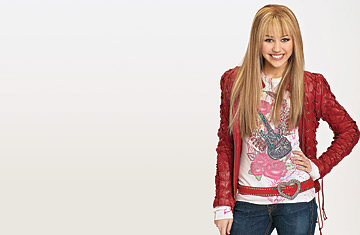
Miley Cyrus stars as Miley Stewart / Hannah Montana on the Disney Original Series Hannah Montana .
She was born with the doubly optimistic name Destiny Hope Cyrus. Her father, achy-breaky country singer Billy Ray Cyrus, nicknamed her "Smiley," which was quickly shortened to "Miley." On her Disney Channel sitcom, she plays Miley Stewart, an ordinary girl with a secret identity: pop-superstar Hannah Montana. On Oct. 18, Cyrus--who has sold millions of very real albums--begins a concert tour, performing as Montana and as ... Miley Cyrus.
Fourteen years old, and America's biggest kids' superstar already has enough personas to fill a postmodern novel. But to Cyrus, reached by phone between tour preparation and an appearance on Ellen, the distinction is not that complicated. "What my fans get, which parents have a harder time grasping, is they know who's underneath Hannah Montana," she says. "They like the girl who's underneath."
And how. Ask a parent who has tried to buy tickets for her tour, which sold out in minutes and have fetched more than $1,000 from scalpers. (The reselling--legal in most states--prompted outrage and lawsuits, giving kids a lesson in the American pillars of capitalism and litigation.) Says Debra Rathwell, senior vice president of AEG Live, the tour's promoter: "I've had e-mails from people saying, 'Should I not pay my mortgage this month and go to Hannah Montana?'" With the popularity of Hannah (and franchises including High School Musical, The Suite Life of Zack and Cody and Cheetah Girls), Disney overtook rival Nickelodeon to become the most-watched cable channel in prime time. You can't even escape Hannah on a dark street; according to CostumZee.com she's the most popular costume this Halloween.
The success of Hannah Montana--the show, the character, the brand--is a marriage of two entertainment families: the Cyruses and Disney. Cyrus was cast after a long search for a show about a meek girl with a secret pop-star life, but, say executive producers Steven Peterman and Michael Poryes, she quickly made the role her own. "Miley is such a pistol, that playing the cautious, introverted girl was not a part of who she was," says Poryes. Her father signed on as her TV dad. "It's art imitating life imitating art," he says. "Miley cut her teeth and learned to walk and sing riding around on my tour bus."
There are lots of TV stars. What made Hannah/Miley a phenom was Disney's learning to use its vast, multimedia holdings. Its stars--young, eager and grateful for the exposure--debut on the Disney Channel. They record CDs for Disney Music. Their music is played on Radio Disney network. They make movies for Disney (a Hannah Montana flick is in the works). They appear on shows like Disney-owned abc's Dancing with the Stars. Cyrus is "really talented," says tween guru and S-Curve Records CEO Steve Greenberg, but also "she really has every arm of a gigantic corporation working at full tilt in an incredibly sophisticated and coordinated fashion toward her success."
Disney has created its own hermetic media world, a mega-subculture led by the promotional power of TV. Disney Channel sound tracks, including Hannah, HSM and The Cheetah Girls 2, have sold nearly 20 million albums in 2006 and 2007, with very little Top 40 airplay. "In television we can add so much texture to the music star," says Gary Marsh, president of Entertainment for Disney Channel Worldwide. "[The fans] know her parents, her friends, what's in her locker, how her bedroom is decorated."
Hannah Montana is Superman for tween girls: she's got the secret identity, a more relevant superpower and a blond wig instead of a cape. But just as key to the show's success is her Clark Kent--the fictional Miley. Celebrity today is as rarefied as ever, yet with YouTube and reality TV, seems more accessible than ever. It's tantalizing but, as personified by Lindsay Lohan and Britney Spears, terrifying. Miley--a normal, grounded schoolkid--makes the fantasy safe. The theme song says it all: "You get the best of both worlds."
The comforting message to parents is that kids are the same as they ever were. They're not, of course--or rather, they're the same but younger. Marketers have coined the concept KGOY, or "Kids get older younger": a 6-year-old follows pop sensations her mother might have at age 10 or 12, and kids differentiate by gender earlier. Disney, says Gary Stibel, president and CEO of the New England Consulting Group, has been "brilliant" in focusing on young girls. "Historically, the marketing rules have said that up until a certain age girls and boys are the same," Stibel says. "That was true 50 years ago. "
The KGOY phenomenon scares the crap out of parents. And yet Hannah manages to take advantage of it--drawing fans as young as preschool--while assuaging parents' fears. Can you put a price tag on a night of wholesome entertainment with your tween daughter? The scalpers have, fairly precisely.
Disney has never cared about being edgy--popular, sure, but not hip. Hipness is about exclusion--who gets it, who doesn't--and there's more money for Disney in being a big, inclusive tent or, rather, a theme park. Unlike, say, Shrek, Hannah Montana has no fast-flying references and in-jokes for the grownups. "People talk about The Simpsons' playing at two levels," says Rich Ross, president of Disney Channel Worldwide. At Disney, he says, "there are no two levels. There's one level that appeals to both." Parents see a retro family sitcom like Full House and its '80s ilk. Kids see themselves idealized.
And Cyrus sees them all looking back at her. On tour, she says, "I'll see a group of 8-year-olds and a group of teenagers with their 80-year-old grandma that took them who's still gonna enjoy the show." Wittingly or not, they're looking at a studio model as old as that granny: create a brand that offers something for everyone. Then sell everyone as much of it as possible.
